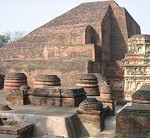The ancient Nalanda University which was at the pinnacle of its excellence between the fifth and 12th centuries was renowned for its multicultural environment. The education centre hosted over a 100 courses in Buddhist studies, astronomy, life sciences, and its reputation drew students from China, Japan, Tibet, Mongolia, Sri Lanka and Turkey; scholars like Fa-Hien, I-tsing and Hiuen Tsang studied at Nalanda.
The new avatar, Nalanda International University Project, is backed by 16 countries apart from India —Australia, Brunei, Cambodia, China, Indonesia, Japan, Laos, Malaysia, Myanmar, New Zealand, Philippines, Singapore, South Korea, Thailand and Vietnam. The seven courses on offer are interdisciplinary in nature and aim to enhance research for greater global interaction, particularly between East Asian countries bound by strong economic, historical and cultural commonalities. 800 years after it was burned to the ground by Turkish invader Bakhtiar Khilji, the new university has opened its doors to 15 doctoral students. Its goal is to bring knowledge back into the discourse of Indian education, and create a centre of excellence in humanities and social sciences – ambitious, given that India does not have an international university, and not even one of its central universities figure in the global top 200.
The project is unique in terms of funding and functioning – all participating countries have contributed financially, the governing board has five appointees from the East Asia Summit countries, and it allows nations that subscribe to the objectives of Nalanda to collaborate. So far, Russia and the U.S. have shown interest. It plans to break away from the rote-learning model typical to most Indian institutions and instead encourage a sharing of ideas. It has been described as an attempt to revive India’s pre-eminence as a center of international learning.
However, the road to Nalanda University has been marred by controversies and innumerable delays. The progress has been painfully slow — opening nine years after it was announced — and undermines India’s attempts to project itself as a soft power.
The idea of a re-imagined Nalanda University was first proposed in 2006 by former president APJ Abdul Kalam. It was picked up immediately by the then Bihar chief minister Nitish Kumar who allotted land close to the Nalanda ruins for a new university to be built. A formal proposal was shared with member states of the East Asian Summit during the Cebu Summit in Philippines in January 2007. The countries endorsed the plan and a mentor group was formed to oversee it with Nobel laureate Professor Amartya Sen at the helm. A few months later, Dr. Kalam disassociated himself from the project, reportedly due to differences over appointments to official positions in the group. Questions were also raised over the group’s decision to function in New Delhi, 700 kms away from the actual site until months before the classes began.
Reports suggest that the launch was rushed as the other governments who have contributed to the project were upset at the lack of progress at all levels. They threatened to pull out unless certain deadlines were met with, which led to the academic session being initiated in 2014. There is competition from the Chinese as well, with President Xi Jinping reiterating the predecessor’s commitment to set up an international university on similar lines in Lumbini, Nepal – another ancient centre of Buddhist learning.
The new Modi government has proposed setting up tourism routes, including a special Buddhist pilgrim circuit in Bihar. If it can ensure that Nalanda University is completed during its tenure, it will do wonders for India on many levels – bring international attention to cultural and spiritual studies – a traditional strength, enhance India’s soft power, as well as show other countries that there is indeed a change in the way Indian bureaucracy functions.
Marisha Dolly Singh is Content Manager with the Gateway House Website.
This blog was exclusively written for Gateway House: Indian Council on Global Relations. You can read more exclusive content here.
For interview requests with the author, or for permission to republish, please contact outreach@gatewayhouse.in.
© Copyright 2014 Gateway House: Indian Council on Global Relations. All rights reserved. Any unauthorized copying or reproduction is strictly prohibited


